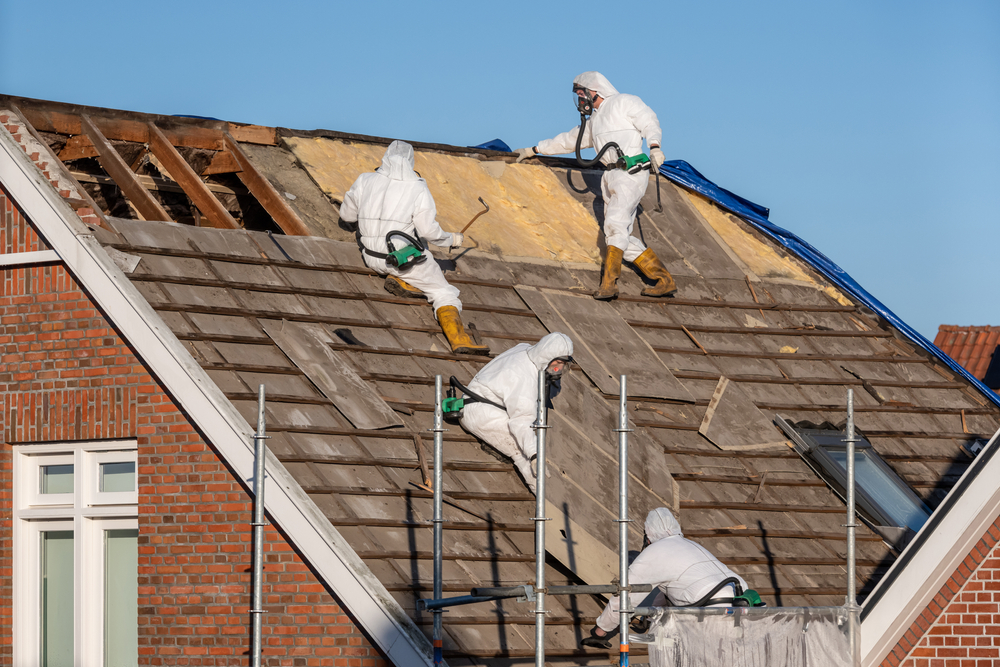Call Us
1-866-968-0479Are you aware of the dangers lurking in your attic and crawl spaces? According to the Environmental Protection Agency (EPA), if your home was built during the 20th century, there’s a good chance it contains asbestos insulation. It is a harmful material that was once commonly used in homes and buildings for its heat-resistant properties. However, it’s now known to cause serious health issues, including lung cancer and mesothelioma.
Identifying asbestos insulation in your home is crucial to your safety. Absolute Roofing and Construction, Inc. provides you with the knowledge to spot this type of insulation and explain why it’s essential to call in professionals for removal. We’ll also discuss safe and modern types of insulation that can replace asbestos. Don’t take any chances with your health! Read on to learn more about identifying and removing asbestos in your home.
Before diving deep into those nooks and crannies to explore asbestos insulation, we would like to ask, in what year was your home built? If you live in a house built before 1980, it’s possible to have asbestos lurking in your attic and crawl spaces. Asbestos can survive high temperatures, so it became popular for insulation. It had many uses, from walls to floors, pipes, and ductwork; even boilers and structural beams were fireproofed with this stuff! Consequently, as soon as the EPA realized the potential dangers of asbestos products being used in homes, they swiftly banned them and prohibited their distribution in 1989.
Although most homes have moved on to safer insulation options, some might still harbor asbestos-containing materials. So, depending on the age of your home, it’s essential to know how to identify and deal with this hazardous material.
Although asbestos is no longer used in insulation products, it poses a considerable risk to your health. Here are a few key facts that allow us to understand the dangers of asbestos.
One of the prominent reasons for its ban was that it is classified as a carcinogen and can cause lung cancer, mesothelioma, or other respiratory ailments if inhaled over long periods.
Moreover, microscopic asbestos fibers are nearly impossible to identify with the naked eye. They may be released into the air during renovation or remodeling projects, increasing inhalation risks. Detecting these tiny particles can be tricky (or even impossible) without proper equipment.
Asbestos inhalation is the world’s number one cause of work-related deaths. Its use was eventually banned in most countries. In the U.S. alone, it leads to more than 39,000 deaths yearly.
Identifying whether your home contains asbestos can be tricky since most materials do not have labels indicating their asbestos content. However, there are a few ways to test for its presence:
Asbestos was used in various insulation materials, including pipe insulation and ceiling tiles. These materials can still be found in older homes built before the ban on asbestos-containing products. Understanding what these insulation materials typically look like is essential to spot them when inspecting your home. Here are a few insulation types that might indicate you might have asbestos.
This type of insulation is often used to line walls and pipes. It looks like a fine, grey powder sprayed onto the surface, creating a drywall-like texture.
Often referred to as “loose fill” or “blown-in” insulation, this material consists of tiny fibers and asbestos particles blown in through a nozzle into wall cavities or around pipes. It has a cotton candy-like appearance and feel.
This type of insulation is commonly found in attics because it’s easy to install between the beams of roofs and floors. It usually consists of brown or yellow paper with an adhesive.
The most reliable way to confirm whether an insulation contains asbestos is by sending samples to a laboratory for testing. If you are unsure about any potential presence of asbestos in your home, get a sample tested from a laboratory accredited by the National Institute of Standards and Technology.
Regarding attics and crawl space insulation, the best way to confront the problem is by hiring professional roofers with experience dealing with asbestos insulation. They can remove it safely and advise you on what kind of replacement material would be best for your attic or crawl space.

Made from recycled paper, it is treated with fire-retardant chemicals to make it less combustible. It also provides excellent soundproofing and moisture protection.
The most common type of insulation, fiberglass, offers exceptional thermal protection and won’t absorb moisture or attract pests.
It is derived from recycled mining slag. Rock wool has superior acoustic insulation properties while providing reasonably good thermal performance.
A dense, rigid foam material made from petroleum products, foam board insulation offers excellent thermal performance for your home.
Foam beads treated with a fire retardant comprise polystyrene insulation, providing excellent soundproofing, moisture protection, and thermal properties.
Related: Water Damage & Crawlspace Insulation Issues
Asbestos insulation is a dangerous material popular before the 1980s. While it offered excellent thermal protection, it posed serious health risks when disturbed. Fortunately, many safe and effective insulation options available today can provide excellent thermal protection without posing any health risks. Make informed decisions about what insulation to install in your home, and always call a professional for removal and installation work.
If you’re looking for reliable and professional insulation services in Parma, OH, look no further than Absolute Roofing and Construction, Inc. Our professional roofers have years of insulation installation experience for residential and commercial properties. We offer various safe and effective insulation options to suit your needs and budget. Contact us today to get a free estimate